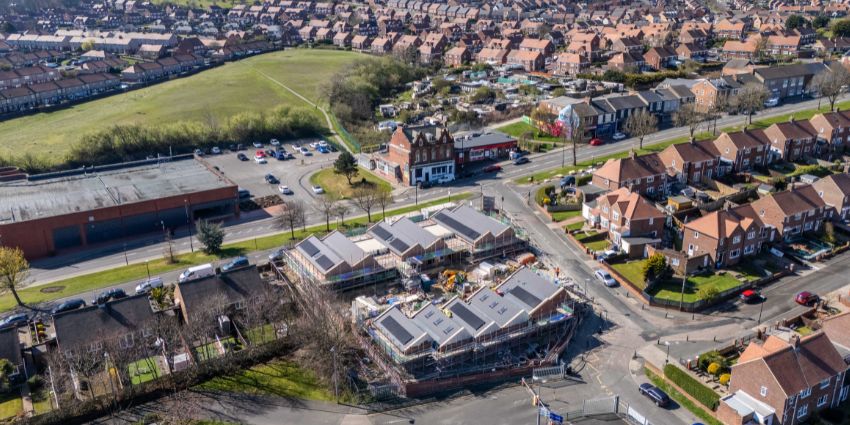How Supported-Living Can Ease Social Housing Concerns

A supported-living housing scheme borne out of a knowledge transfer partnership (KTP) spanning architecture design, academia, and tech innovation is nearing completion in the North East of England to better support adults requiring social care.
Building Design Northern (BDN), along with Northumbria University and Innovate UK, have, in collaboration with Sunderland City Council, created a new development that promotes housing longevity, and community engagement.
The scheme, St Cuthbert’s Close in Ryhope, Sunderland, is currently in construction and is part of the council’s visionary five-year, £59m housing delivery and investment plan (HDIP).
The two and three-bedroom shared properties have been designed to create a safe, enclosed environment with a strong community feel, enabling residents to have greater and continuous opportunities for social interaction, both within and around the dwellings. It also includes two staff resource hubs enabling daily support and living assistance.
What Supported-living Experts Say
Filip Young, Associate Architect at Building Design Northern (BDN), explained: “Research data shows that the UK has an aging population with millions more people now living to a far greater age than ever before.
Therefore, housing schemes that are being considered, designed, and developed today very much need to consider our ever-changing lifestyles and how we can better support those who may require additional support to live safely and securely in their own home in the future.
“From an architectural design and planning perspective, the development has been designed in a courtyard arrangement with principal entrances facing shared spaces, creating pockets of communal areas to foster interaction amongst residents as well as visitors.
The properties also have centrally located rise-and-fall kitchens to improve accessibility and re-establish the heart of the home.
Furthermore, windows and ceilings are larger and higher than standard to create airy, bright spaces, which have been proven to improve the wellbeing for users.
“By working in partnership with Northumbria University and sharing our respective areas of expertise, BDN has been able to design highly specialist homes and create a community that is bespoke and fit-for-purpose – promoting social inclusion, independence through care, and meeting tomorrow’s needs today.”
Through academic research and with support from Innovate UK, we have been able to explore longevity housing in far greater depth, the results of which are now coming to fruition at St Cuthbert’s Close.
The development, built on the site of the former St Cuthbert’s Methodist Church, is expected to be completed Summer 2025.
Sunderland City Council’s Housing Delivery and Investment Plan (HDIP) aims to deliver 193 accessible properties, 210 general-needs homes through empty home conversions, and 171 supported homes by 2025, with the council having spent or committed £23 million of the allocated funds.
Cllr Kevin Johnston, Dynamic City Portfolio Holder at Sunderland City Council, added: “St Cuthbert’s Close is a great example of collaborative working with BDN, Northumbria University, Innovate UK, and Sunderland City Council, all demonstrating how knowledge transfer partnerships can deliver the very best outcomes for Wearside residents and the city going forward.
The Housing Delivery and Investment Plan is our commitment to providing homes for those who require additional care services and, therefore properties that are attuned to their specific needs.
“By creating such developments, we can fully support all residents, giving everyone a real sense of community whilst promoting mobility, wellbeing and reducing isolation.”
What Does Supported-living Mean for Social Housing?
Supporting living housing schemes for the elderly can address social housing challenges in several ways:
- Freeing Up Larger Homes: Elderly individuals often live in homes that are larger than their current needs. By moving to supported living schemes, these larger properties can be made available to families in need of social housing.
- Reducing Healthcare Costs: These schemes provide tailored care and support, enabling elderly residents to live independently for longer. This reduces the strain on healthcare systems and allows resources to be redirected to other social housing initiatives.
- Community Integration: Supported living schemes often foster a sense of community, reducing isolation among elderly residents. This can lead to stronger neighbourhood ties and more cohesive communities.
- Efficient Use of Resources: By offering specialized housing options like retirement villages or extra care housing, local councils can better allocate resources to meet the diverse needs of their populations.

